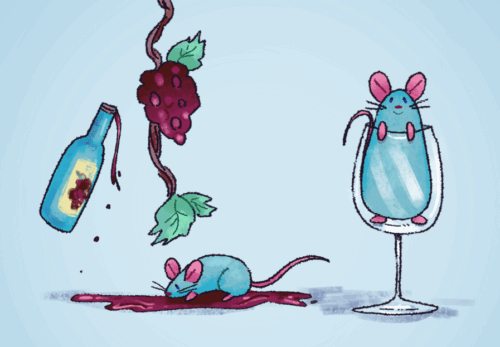Art by Dahlia Kordit
Depictions of animals in film are often fictitiously personified. Popular movie Ratatouille exemplifies this genre with the cooking rat Remy’s compulsion for distinct flavor profiles and generational cooking skills. While it may seem obvious that a real-life rat would not possess Remy’s culinary literacy, a study published by Elisa Frasnelli, an associate professor and researcher at the University of Trento, and her collaborators provide new insight into distinct similarities between abilities of humans and rats to differentiate different scent profiles.
In the slim yet robust field of interspecial olfactory science, the study and comparison of scent processes across different species, there is much debate on the deftness of human versus non-human olfaction. It is hypothesized that humans use both linguistics and cognitive categories to discern different scents. By assigning labels to different smells, humans can compensate for their relative paucity of olfactory receptors compared to other mammals. Such a reduction in olfactory capacity seems to be paired to our optical development through evolution. “From an evolutionary point of view, the idea that we have less olfactory receptor genes is thought to be explained with the fact that we improved our vision […] while humans are primates and can rely on vision more, other animals are heavily reliant on olfaction,” Frasnelli said. Knowing this, it’s reasonable to argue that in gaining capabilities such as cognition-based categorization, we compromised some of our olfactory receptors.
While this thought process seems sound, there have been no studies attempting to disprove the notion that non-human animals are unable to categorize scent profiles to better differentiate scents. Frasnelli’s study suggests otherwise. In order to discern whether rats would categorize and generalize scents, rats were trained in isolated chambers to smell two grape varieties, each with four brands of wines summing to a total of eight distinct wines. The rats were trained using a reward system to push a lever when they correctly identified one grape variety over the other. Two new wines, one of each grape variety, were added, and the rats were tested to see if they could correctly select the same grape variety. “We knew that they were amazing at discriminating smells, so that wasn’t so surprising. But the fact that they could generalize was really striking,” Frasnelli said. Seven of nine rats passed this test, supporting the notion that rats were using a generalization and categorization strategy to choose wines.
“[What was] especially intriguing was that there was one specific wine, which was a challenging one even for us as authors […] we even smelled it and we tasted it at some point,” Frasnelli said. While the positive results support the notion that rats could generalize wines and possibly other scents into groups, this peculiar caveat suggests that cognition-based categorization may not be necessary for distinguishing smells. Even with human cognitive abilities, the researchers were unable to differentiate between this wine and other wines of the same grape variety. One possible explanation is that similarities in human and rat olfaction arise as a result of similarities in olfactory receptor genes. It is difficult to test the viability of this theory, however, as humans are known to utilize different perceptual dimensions simultaneously in order to elevate our olfactory senses. For example, when we drink wine, we also smell and use our tactile senses on our tongue to help us discern the wine based on its other qualities. Meanwhile, the rats in the experiment were only allowed to smell the samples. Due to these different perceptual dimensions, it is hard to conclude the exact source of the similarities and differences underlying olfactory acuity across species. Regardless, one thing is clear: humans and rats are more similar than we previously thought.
Frasnelli’s inspiration for such an unorthodox study arose during a wine tasting experience, sparking an interest as to whether animals could also differentiate wines. While this abrupt project began as simple curiosity, the results could overturn the current beliefs of processes and factors that underlie non-human olfaction. “I think that [an important] question that arises from these studies is whether language is important to form those [scent] categories,” Frasnelli said. Frasnelli is excited to explore future directions that could reveal more about this connection, informing future research involving rat models.

